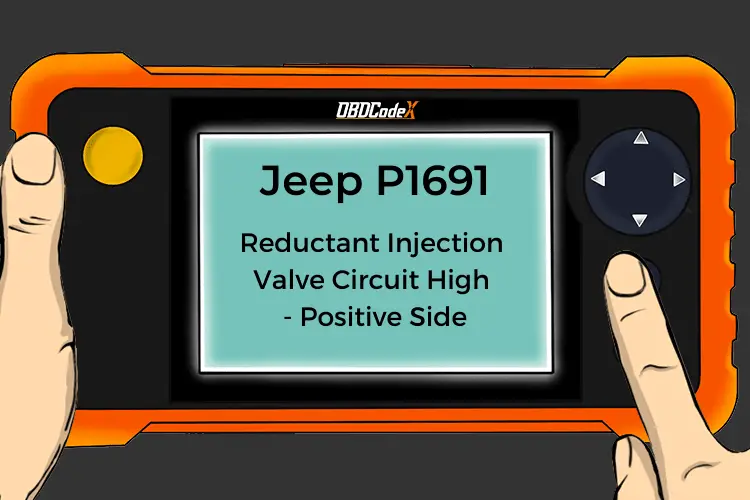P2050: Reductant Injection Valve Circuit/Open Bank 2 Unit 1
Is your scanner showing P2050?
No worries. We'll show you what it means and how to deal with it.
P2050: Reductant Injection Valve Circuit/Open Bank 2 Unit 1
OVERVIEWWhat Does The P2050 Code Mean?
A stored code P2050 means that the powertrain control module (PCM) has detected no voltage in the control circuit for the reductant injection valve for engine bank two and selective catalyst reduction (SCR) system one. Bank 2 refers to the bank of the engine that does NOT contain the number one cylinder.
The catalyst system is responsible for reduction of (basically) all exhaust emissions although certain applications are also equipped with a NOx trap.
Exhaust gas recirculation (EGR) systems go another step further in the reduction of NOx. Nevertheless, today’s larger and more powerful diesel engines cannot meet strict federal (U.S.) emission standards with the EGR, diesel particulate filter/catalytic converter, and NOx trap alone. It was for this reason that selective catalytic reduction (SCR) systems were invented.
SCR systems inject a reductant compound or a diesel exhaust fluid (DEF) into the exhaust in front of the diesel particulate filter, NOx trap, and/or the catalytic converter via the reductant injection valve (solenoid). The precisely timed DEF injection elevates the temperature of the filtration element and allows it to perform more efficiently. It enhances filtration element longevity and allows fewer harmful exhaust emissions to be released into the atmosphere.
The entire SCR system is monitored and controlled by either the PCM or a stand-alone controller (which interacts with the PCM). Either way, the controller monitors the O2, NOx, and exhaust temperature sensors (as well as other inputs) to determine the appropriate time for DEF (reductant) injection. Precise DEF injection is necessary to maintain exhaust temperature within acceptable parameters and optimize pollutant filtration.
Reductant heaters are used to prevent diesel exhaust fluid from freezing during extreme temperatures. These heaters are typically located in the DEF reservoir and/or the reductant injector supply hose/s.
If the PCM detects no voltage on the control circuit for the reductant injection valve for engine bank two unit one, a code P2050 will be stored and a malfunction indicator lamp may be illuminated.
What Are The Symptoms Of The P2050 Code?
Symptoms of a P2050 trouble code may include:
- Diminished engine performance
- Excessive black smoke from vehicle exhaust
- Reduction in fuel efficiency
- Other SCR related codes
What Are The Potential Causes Of The P2050 Code?
Causes for this code may include:
- Bad reductant injection valve
- Open or shorted circuits in the reductant injection valve control
- Insufficient DEF in the reservoir
- Bad SCR controller/PCM or programming error
How Serious Is This P2050 Code?
A stored code P2050 should be considered severe and addressed as quickly as possible. The SCR system could be disabled because of it. Catalyst damage could result if the conditions which contributed to the code being stored are not rectified in a timely manner.
How Can You Fix The P2050 Code?
Tools required
You will need access to a diagnostic scanner, a digital volt/ohmmeter (DVOM), and a source of vehicle specific diagnostic information to diagnose a code P2050.
If you can find a technical service bulletin (TSB) that matches the vehicle year, make, and model; as well as the engine size, code/s stored, and symptoms exhibited, it could yield helpful diagnostic information.
Step-by-step guide
You will want to begin your diagnosis with a visual inspection of the reductant heater system harnesses and connectors. Burnt or damaged wiring and or connectors should be repaired or replaced before proceeding.
Proceed by hooking the scanner to the vehicle diagnostic connector and retrieving all stored codes and pertinent freeze frame data. Write this information down before clearing the codes and test driving the vehicle until the PCM either enters readiness mode or the code is reset.
The code is intermittent and may be much more difficult to diagnose (at this time), if the PCM enters readiness mode. If this is the case, the conditions which contributed to the code being stored may need to worsen before an accurate diagnosis can be made.
Should the code be reset, search your source of vehicle information to obtain diagnostic flow charts, connector pin out charts, connector face views, as well as component testing procedures and specifications. This information will be required to complete the next step of your diagnosis.
Use the DVOM to test the power supply to the SCR control system. Test fuses with the circuit loaded to avoid misdiagnosis. If the appropriate power (battery voltage) and ground circuits are discovered, use the scanner to activate the reductant injector valve (solenoid) and test output control circuit voltage. If voltage is insufficient, suspect that the controller is bad or has experienced a programming error.
If the voltage output circuit is within parameters, use the DVOM to test the reductant injection valve in question. If the valve fails to meet manufacturer’s specifications, suspect that it has failed.
Note: The reductant injection valve is actually a solenoid based injector that sprays reduction fluid into the exhaust
Reference Sources
P2050 Reductant Injection Valve Circuit/Open Bank 2 Unit 1, OBD-Codes.




